July 4, 2025

The primary objective of this article is to exemplify conditioned responses within the realm of behavior analysis, elucidating the mechanisms by which these responses are established and their implications across various contexts. This discussion is anchored in classical conditioning experiments, such as Pavlov's dogs and the Little Albert experiment. These studies compellingly illustrate how neutral stimuli can elicit profound emotional and behavioral reactions through learned associations.
Exploring the intricate world of conditioned responses reveals profound insights into human behavior and learning. With the demand for Board Certified Behavior Analysts (BCBAs) surging, understanding these principles is essential for professionals navigating the complexities of therapy and behavior modification.
From Pavlov's iconic experiments with dogs to the ethical implications of emotional conditioning in advertising, these examples illuminate the mechanisms by which behaviors are acquired and modified.
As we delve deeper into this topic, it becomes clear that grasping these concepts is not merely academic; it is a necessity for those committed to advancing in the field.
In the rapidly evolving field of Applied Behavior Analysis (ABA) therapy, the demand for Board Certified Behavior Analysts (BCBAs) is projected to surge by 25% by 2026. This statistic underscores a critical need for effective recruitment solutions. Hire ABA stands out as a specialized recruitment platform that connects BCBAs with premier job opportunities tailored to their expertise and career aspirations.
Are you facing challenges in hiring qualified professionals? Hire ABA enhances the hiring process, making it easier for candidates to find roles that align with their skills and goals. Our personalized resume assessments allow candidates to submit their resumes for evaluation, where our expert team reviews their experience and aspirations. By implementing advanced job fit scoring, we pinpoint opportunities that match their preferences and desired locations.
This streamlined support not only facilitates candidates' advancement in ABA therapy but also addresses the expanding employment opportunities across various settings. With growth rates projected at 30% in schools and 25% in clinics, the landscape for BCBAs is promising. As the demand for these professionals continues to rise, platforms like Hire ABA play a pivotal role in connecting talent with opportunities.
Ultimately, Hire ABA contributes significantly to the effectiveness of ABA therapy, which supports individuals with autism and related conditions. Take action today and explore how Hire ABA can transform your recruitment strategy, ensuring you secure the best talent in this vital field.
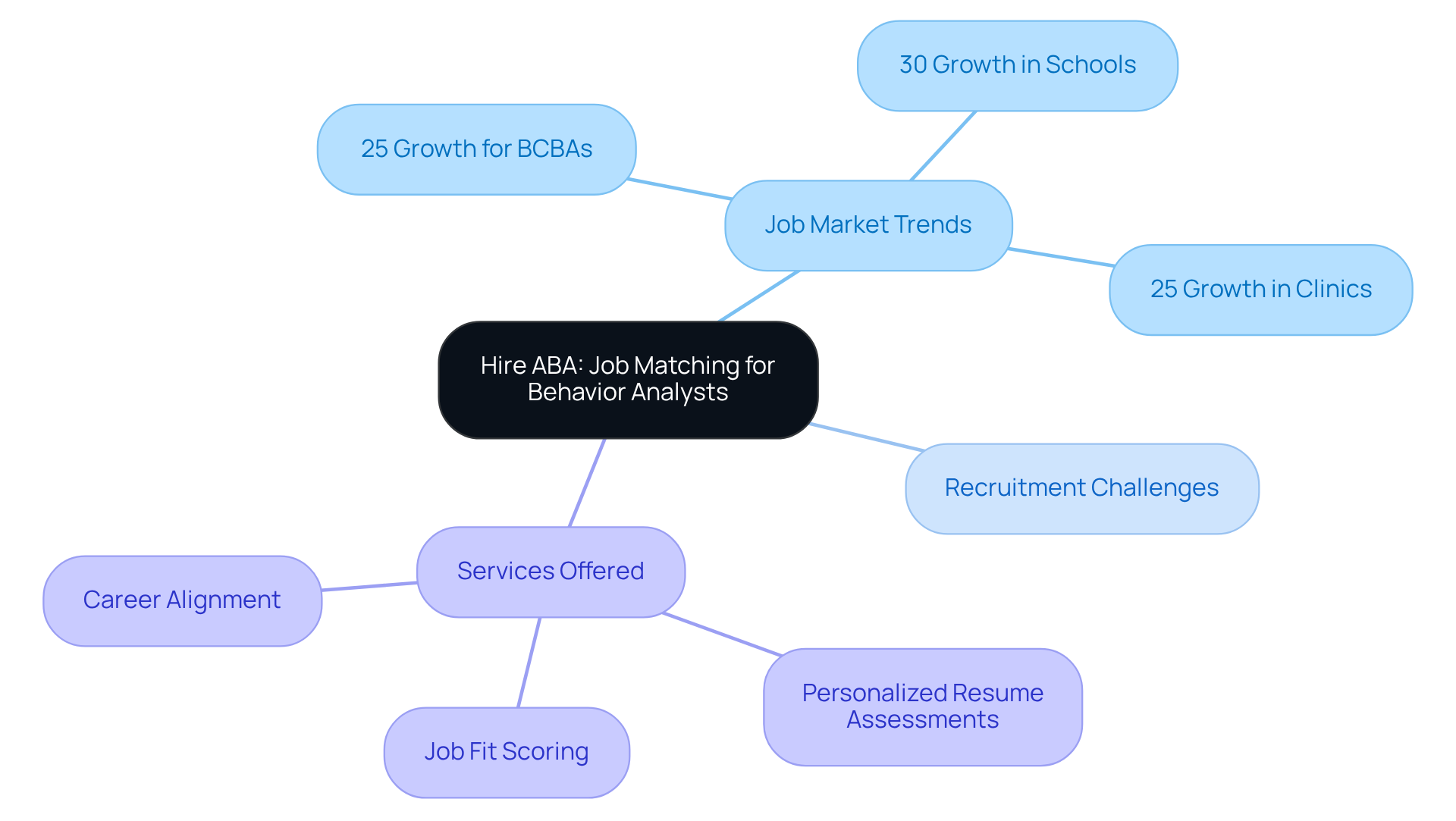
The demand for Board Certified Behavior Analysts (BCBAs) is projected to soar by 25% by 2026. This statistic underscores the growing importance of understanding classical conditioning, a fundamental concept rooted in Ivan Pavlov's groundbreaking experiments with dogs. In his pivotal study, Pavlov paired a neutral stimulus—the sound of a bell—with an unconditioned stimulus, food. Through repeated associations, the dogs learned to salivate at the sound of the bell alone, which serves as a conditioned response example of how a previously neutral signal can evoke a reaction.
Pavlov's research not only laid the groundwork for classical conditioning but also offered vital insights into behavior modification techniques that are widely utilized in various therapeutic settings today. The implications of his findings extend far beyond the laboratory, influencing modern practices in behavior analysis. Understanding how environmental signals can trigger learned behaviors is essential for those in the field.
As the landscape of ABA therapy evolves, the opportunities for BCBAs are expanding. This growing market presents numerous avenues, including leadership and remote roles, enabling BCBAs to positively impact more lives while advancing their careers. Are you facing challenges in hiring qualified professionals? Consider how Hire ABA can streamline your recruitment process and connect you with top talent in the field.
In summary, grasping the principles of classical conditioning is increasingly relevant for professionals navigating their careers in ABA therapy. By leveraging platforms like Hire ABA, you can ensure that your organization is equipped with the expertise needed to thrive in this dynamic environment.
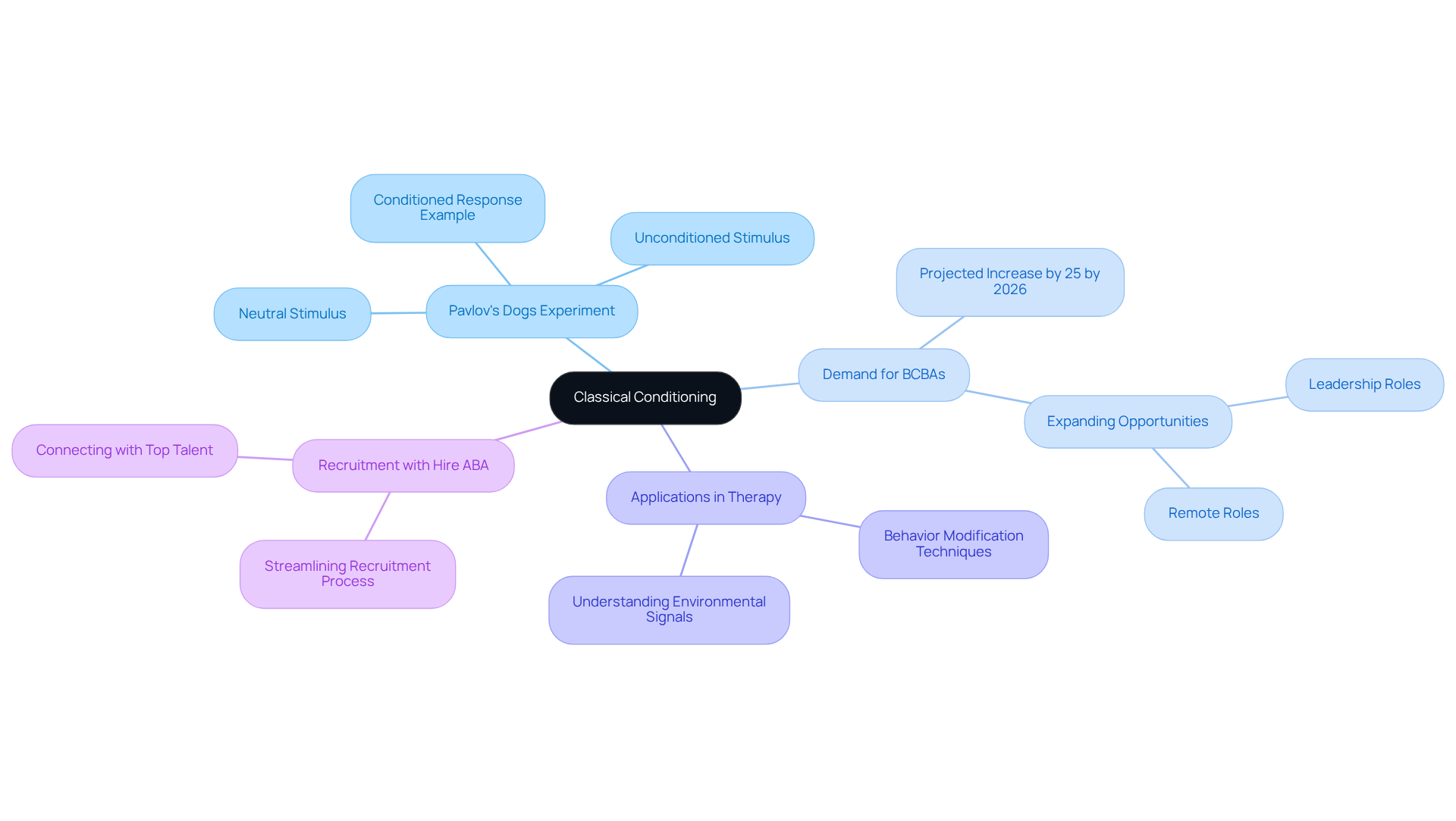
Conducted by John B. Watson and Rosalie Rayner in 1919, the Little Albert experiment aimed to demonstrate that emotional reactions could be learned in humans. This contentious research involved a previously fearless infant who was introduced to a white rat, a neutral object, while simultaneously exposed to loud, terrifying noises, which served as the unconditioned trigger. As a result, Little Albert developed a fear of the rat, a fear that generalized to other similar stimuli. This finding illustrates the process of learned fear and suggests that such reactions can extend beyond the initial stimulus.
The implications of this experiment reach far beyond its immediate findings, raising significant ethical concerns that resonate in contemporary discussions surrounding psychological research. Critics argue that the absence of informed consent and the emotional distress inflicted on Little Albert underscore the necessity for stringent ethical standards in psychological studies. Moreover, the small sample size and lack of control over variables cast doubt on the internal validity of the experiment.
Contemporary behavior analysts emphasize that while training can clarify specific emotional reactions, it is crucial to consider the broader context of a child's emotional and cognitive development. Notably, it has been revealed that Little Albert suffered from hydrocephalus, which may have influenced his behavior during the experiment, further raising ethical concerns about the appropriateness of using him as a subject.
Additionally, the experiment serves as a conditioned response example in understanding how fear reactions are conditioned in infants, which impacts therapeutic approaches for phobias and anxiety disorders. As behavior analysts continue to explore the complexities of emotional training, they acknowledge that fear responses result not only from such training but are also shaped by personal temperament and environmental factors. This nuanced understanding highlights the importance of ethical considerations in research involving vulnerable populations, ensuring that the dignity and well-being of participants are prioritized.
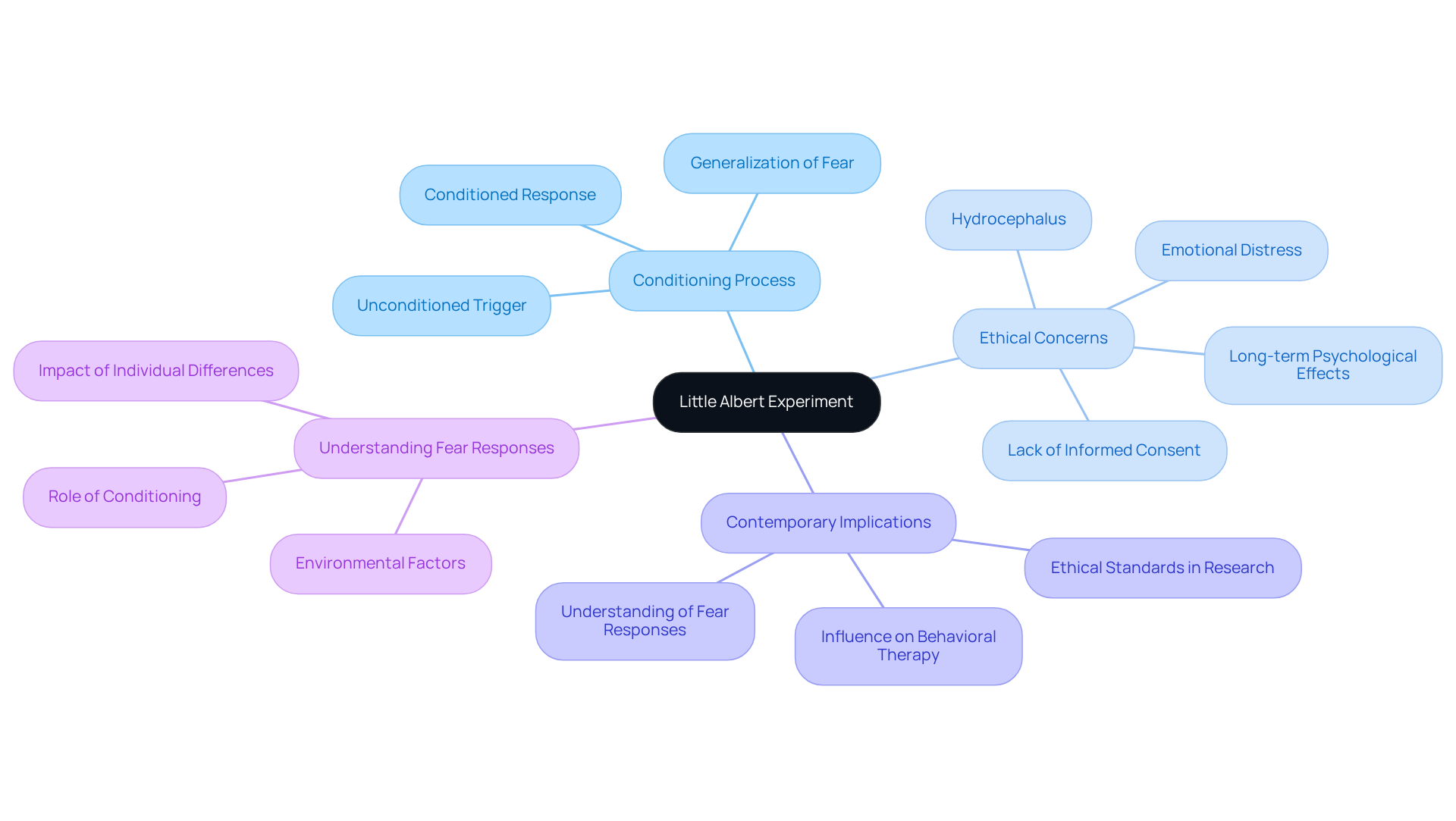
Taste aversion conditioning is a phenomenon where an individual associates the taste of a specific food with feelings of illness or discomfort. For instance, if someone consumes sushi and later experiences nausea, they may develop a lasting aversion to sushi, irrespective of whether it was the actual cause of their sickness. This response acts as a vital survival mechanism, empowering individuals to avoid potentially harmful foods in the future. Research indicates that learned taste aversion (CTA) can endure long after the initial negative experience, underscoring its profound impact on dietary choices. Notably, studies reveal that a CTA can form even with a 24-hour delay between the conditioned stimulus (the food) and the unconditioned stimulus (the illness), resulting in a robust aversion.
A conditioned response example can be seen in everyday instances of taste aversion, where children often reject foods they once enjoyed after a single negative experience, such as vomiting after consuming a particular dish. This response is not confined to children; adults can also develop aversions based on past experiences, significantly influencing their dietary habits. The widespread nature of food aversions linked to illness experiences highlights the importance of understanding how our interactions with food shape our preferences.
Nutritionists assert that food experiences play a crucial role in molding our preferences. As one expert aptly stated, 'The food you eat can be either the safest and most powerful form of medicine or the slowest form of poison.' This statement emphasizes the necessity for mindful eating practices, given that positive or negative experiences with food can lead to long-term changes in dietary choices. Ultimately, taste aversion conditioning illustrates the deep connection between our experiences and our food preferences, guiding us toward healthier choices in the long run.
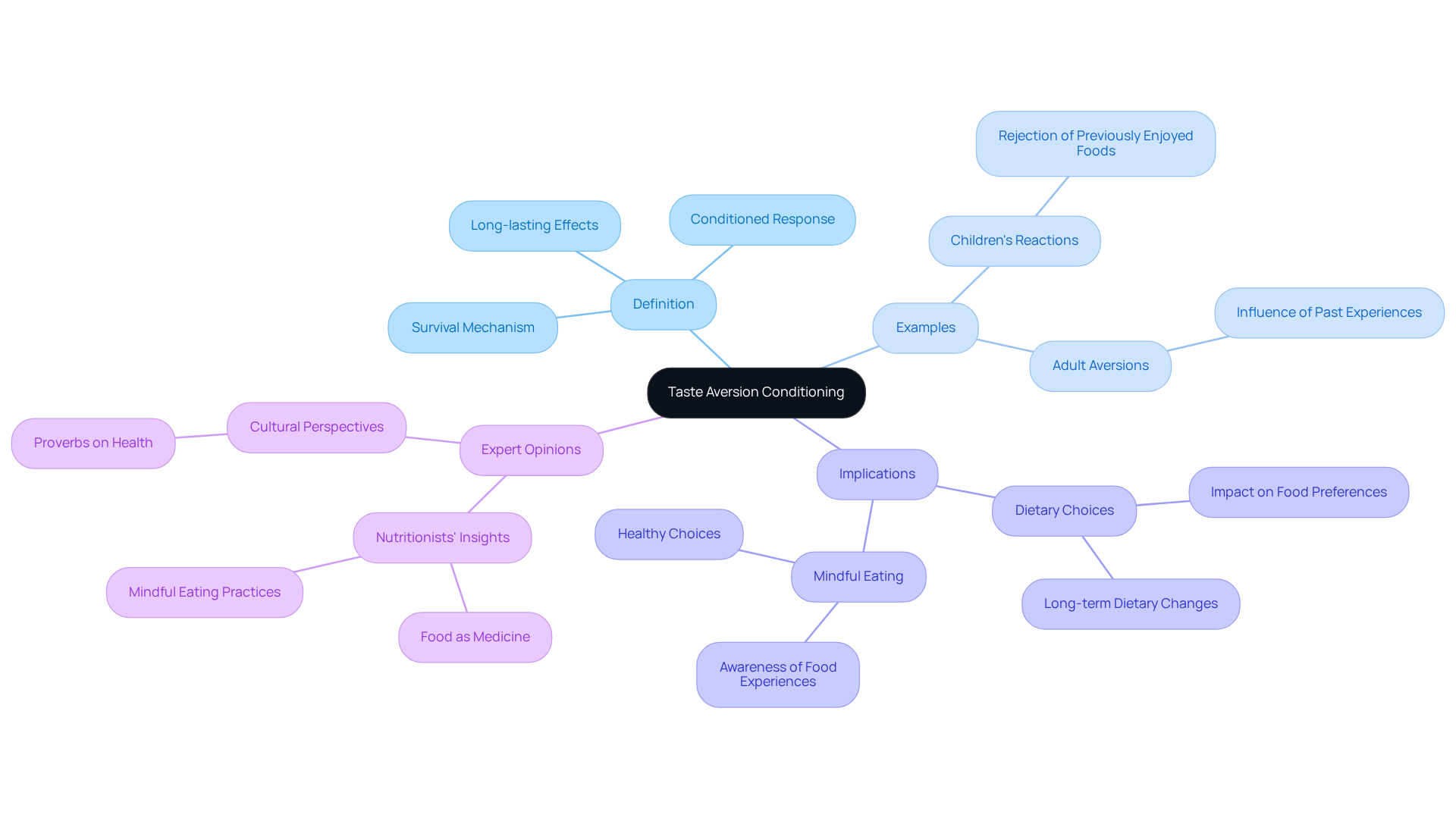
Spontaneous recovery is a significant phenomenon in behavioral psychology, where a previously extinguished learned response re-emerges after a period without exposure to the stimulus.
For example, a dog that salivates at the sound of a bell serves as a conditioned response example. If the bell is rung without presenting food, the dog may cease to respond. However, after a rest period, it is possible for the dog to salivate again at the sound of the bell.
This concept highlights not only the resilience of learned behaviors but also the complexities involved in behavior modification.
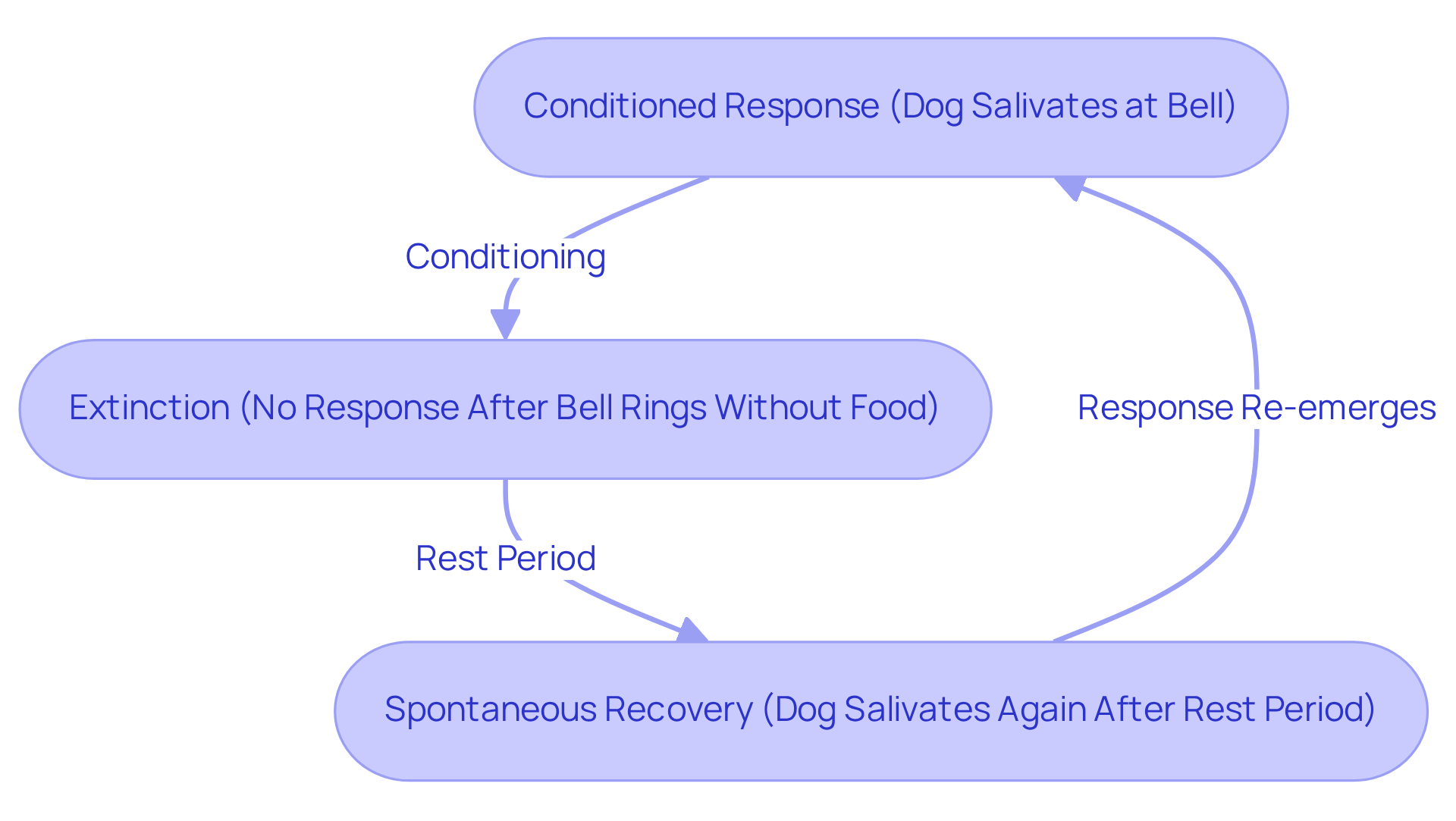
Respondent conditioning techniques are pivotal in therapy, particularly for addressing phobias and anxiety disorders. Systematic desensitization, a method developed by Joseph Wolpe, involves progressively exposing clients to their feared triggers in a controlled environment. This strategy is a conditioned response example, allowing individuals to learn to associate these stimuli with relaxation instead of fear, effectively diminishing anxiety over time. Research indicates that approximately 75% of patients with phobias respond positively to systematic desensitization, underscoring its effectiveness in therapeutic contexts.
In practice, therapists typically initiate the process by teaching relaxation techniques such as deep breathing and progressive muscle relaxation, which are crucial for managing anxiety during exposure. As Geralyn Dexter, PhD, LMHC, emphasizes, "Developing strategies to help you relax your body during moments of distress is the first step of systematic desensitization." Subsequently, clients construct a fear hierarchy, ranking their fears from least to most distressing. This structured method facilitates gradual confrontation of fears, beginning with less intimidating scenarios and advancing to more challenging ones. For example, a patient with a fear of dogs may start by viewing pictures before ultimately interacting with a dog.
Recent studies reveal that systematic desensitization can lead to substantial improvements in anxiety management, with some patients experiencing symptom reduction after just a few sessions. In fact, 90% of individuals who undergo in vivo exposure report decreased fear, less avoidance, and diminished overall impairment. This approach not only empowers patients to face their fears but also cultivates a sense of control over their anxiety.
Therapists stress the necessity of customizing the systematic desensitization process to meet each individual's needs, ensuring that the pace of exposure aligns with their comfort levels. As the field of therapy evolves, systematic desensitization is a classic conditioned response example that highlights the enduring significance of classical principles in contemporary therapeutic practices. Typically, the process may require an average of 6-8 sessions, contingent upon the individual's specific needs and progress. Moreover, a study by Lang et al. (1963) demonstrated the effectiveness of systematic desensitization with college students suffering from snake phobia, further validating this approach.
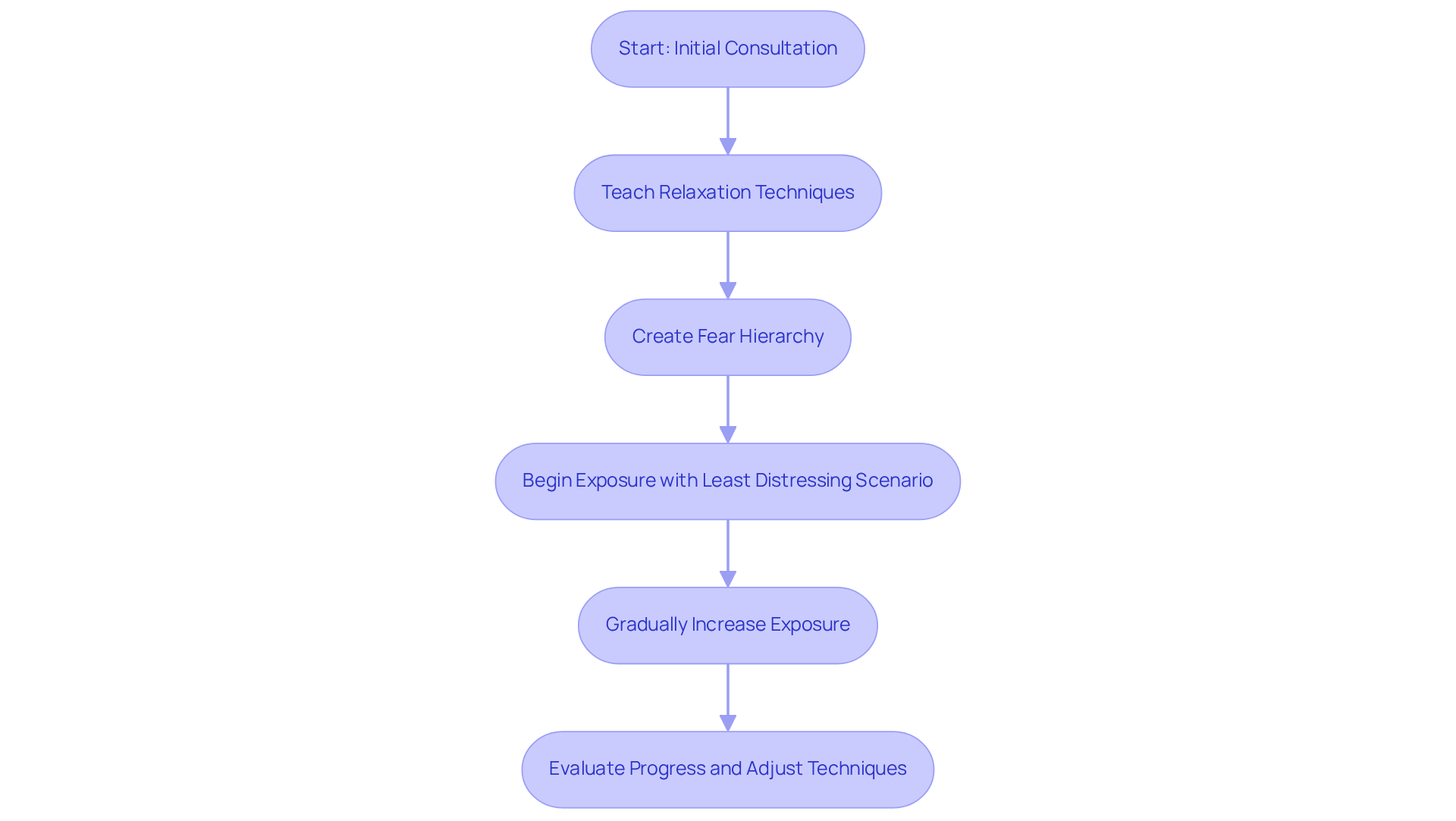
The application of respondent training in advertising introduces critical ethical considerations. A conditioned response example can be seen when advertisers link products with positive stimuli, such as appealing visuals or enjoyable music, to elicit favorable emotional responses from consumers. This technique, while effective, raises important questions regarding manipulation and consumer autonomy.
Behavior analysts must carefully evaluate the ethical implications of their methodologies, ensuring that training practices are implemented responsibly and transparently within marketing strategies.
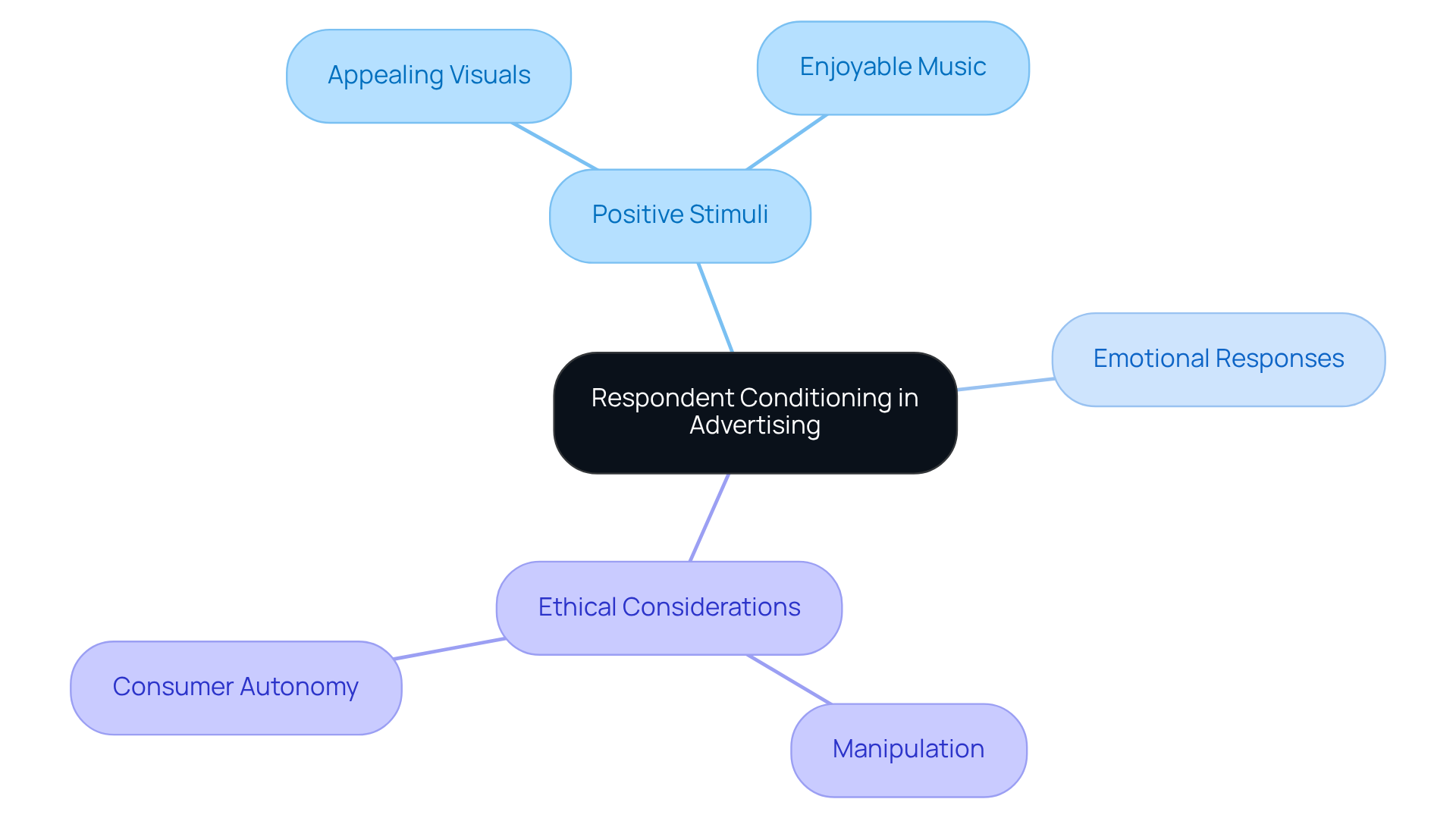
An example of a conditioned response occurs when a neutral factor is associated with a specific emotional reaction through training. For instance, if a person experiences a traumatic event while listening to a specific song, they may later feel anxious or distressed upon hearing that song again. This phenomenon illustrates how emotions can be influenced, carrying significant implications for therapeutic practices, particularly in addressing trauma and anxiety disorders.
Current research underscores that emotional conditioning can shape how individuals respond to stimuli associated with past traumas. Studies indicate that trauma survivors frequently develop learned reactions to signals reminiscent of their experiences, which can perpetuate feelings of fear and helplessness. Psychologists emphasize that understanding these conditioned responses is essential for effective therapy. Bessel van der Kolk, a leading expert in trauma, notes that trauma reshapes both the body and brain, affecting how individuals perceive and react to their environment. He further highlights that individuals who were abused in childhood often do not feel secure with anyone, emphasizing the lasting impacts of trauma on emotional development.
Moreover, emotional training can manifest in various therapeutic contexts. For example, exposure therapy, which gradually familiarizes patients with anxiety-inducing stimuli in a controlled setting, serves as a conditioned response example by employing the concepts of conditioning to assist individuals in re-evaluating their emotional reactions. This approach has shown potential in diminishing the strength of learned reactions over time, enabling individuals to restore their emotional health. Additionally, social support is a biological necessity, not merely an option, for mental health, underscoring the importance of supportive environments in trauma recovery. The role of social support in trauma recovery is critical, as evidenced by case studies that demonstrate how strong social connections provide significant protection against the overwhelming effects of trauma.
In summary, the interaction between learned behaviors and emotions is a vital area of focus in trauma therapy, highlighting the need for customized strategies that cater to the distinct emotional landscapes of trauma survivors. The weight of trauma does not diminish with time; rather, it amplifies if overlooked or repressed, emphasizing the necessity of addressing learned emotional reactions in therapy.
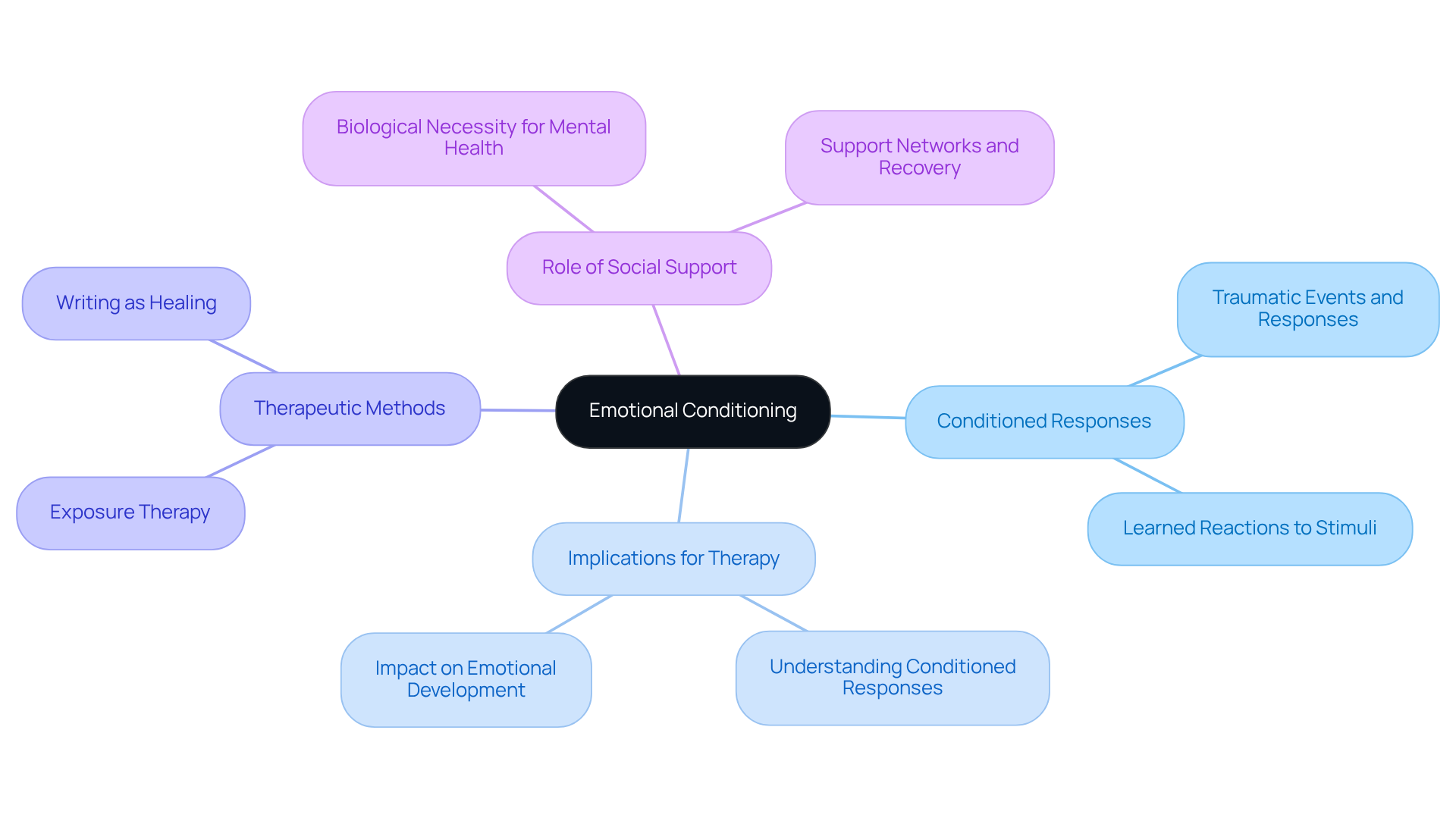
Second-order learning occurs when a conditioned stimulus (CS1) is linked to a new neutral stimulus (CS2), which serves as a conditioned response example, resulting in the new stimulus eliciting the conditioned response. For example, a dog that demonstrates a conditioned response example by associating a bell with food (first-order learning) may later learn to connect a light with the bell, resulting in salivation at the light alone. This illustrates the evolution of complex behavior patterns through various training levels, highlighting the intricacies of learning and behavior modification.
Ongoing studies indicate a significant demand for Board Certified Behavior Analysts (BCBAs), projected to increase by 25% by 2026. This underscores the necessity of understanding second-order learning within therapeutic environments. Additionally, research by Milad et al. (2009) reveals that individuals with PTSD exhibit slower extinction in classical training tasks. Such insights are essential for behavior analysts when developing interventions tailored for clients with trauma histories.
Pavlov's foundational experiments in classical conditioning laid the groundwork for comprehending these principles, demonstrating how organisms learn to associate stimuli. The exploration of second-order training provides valuable insights into the mechanisms of learning and behavior modification. As noted by Jessica C. Lee, gathering evidence for second-order learning in humans presents challenges, complicating its application in behavior analysis.
An example of a conditioned response can be observed in second-order conditioning, which has practical implications for behavior modification, particularly in therapeutic settings. By systematically pairing neutral cues with well-established learned signals, therapists can facilitate the transformation of maladaptive behaviors into more appropriate responses. For instance, a dog that initially fears a specific sound can be gradually desensitized by associating that sound with positive experiences, such as treats or playtime.
Real-world examples of complex behavior patterns in dogs illustrate their ability to generalize learned responses to similar triggers. A dog conditioned to respond to a specific command may also react to variations of that command, exemplifying the principles of stimulus generalization. Behavior analysts stress the importance of recognizing these patterns to develop effective training and rehabilitation programs.
Experts in the field assert that investigating second-order conditioning yields valuable insights into the mechanisms of learning and behavior modification. Grasping these complex interactions not only deepens our understanding of animal behavior but also guides the formulation of effective therapeutic strategies for various behavioral challenges.
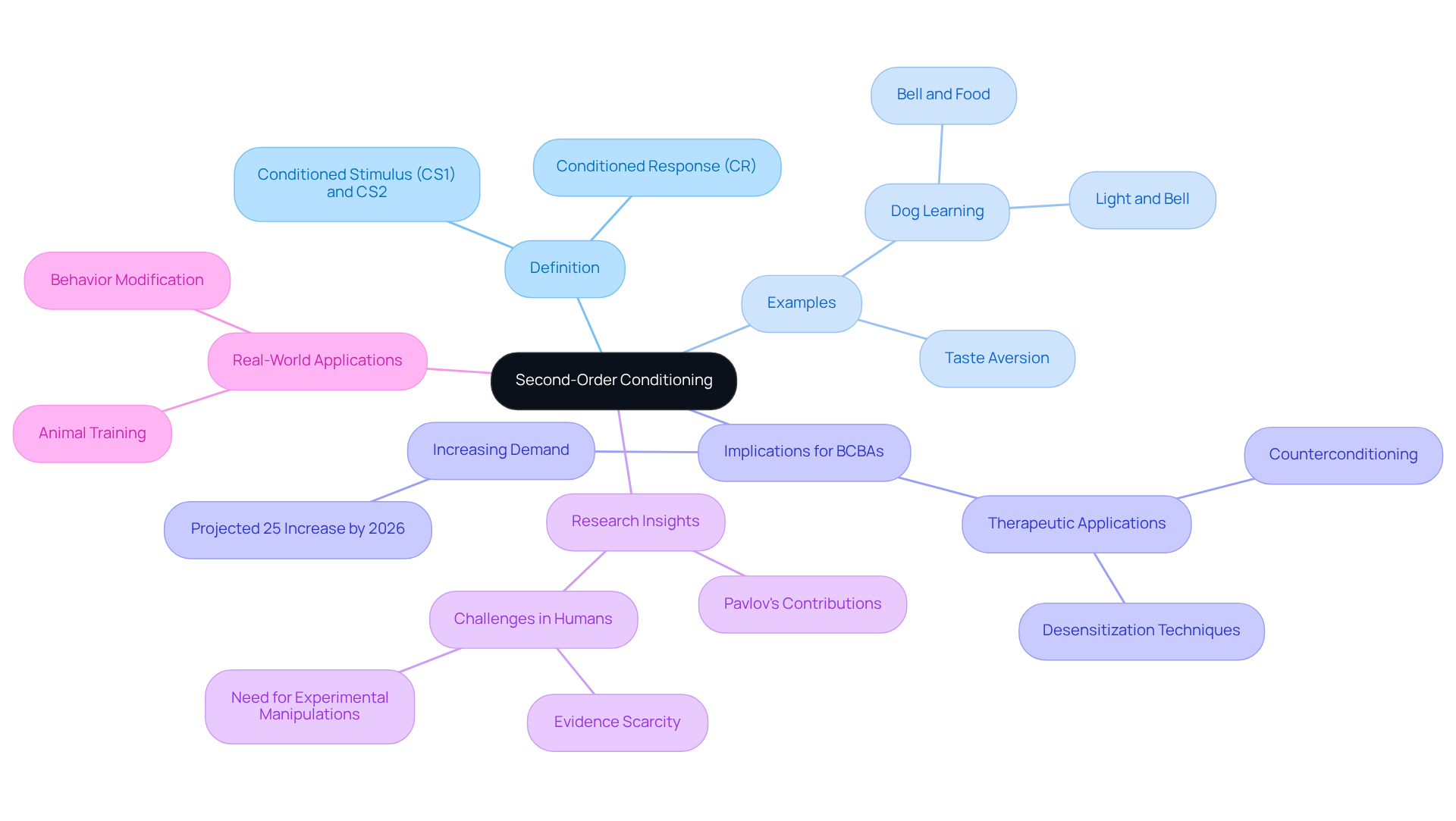
Understanding conditioned responses is crucial in the field of behavior analysis, laying the foundation for various therapeutic practices and interventions. The demand for qualified professionals in this area is significant, with a growing need for Board Certified Behavior Analysts (BCBAs). Through the exploration of classic experiments and modern applications, the significance of these responses extends beyond academic inquiry, impacting real-world scenarios involving behavior modification and emotional conditioning.
Pivotal examples such as Pavlov's Dogs, the Little Albert experiment, and taste aversion conditioning demonstrate how learned behaviors can be shaped by environmental stimuli. Have you considered how these principles influence your hiring practices? Concepts like spontaneous recovery and second-order conditioning illustrate the complexities of behavioral responses and their implications in therapeutic settings. These insights not only enhance the effectiveness of interventions for phobias and anxiety but also underscore the ethical considerations necessary when applying these principles in practice.
Ultimately, the exploration of conditioned responses serves as a reminder of the profound influence that experiences have on behavior and emotions. As the demand for qualified professionals in behavior analysis continues to rise, it is imperative to leverage platforms like Hire ABA to connect talent with opportunities in this vital field. By embracing these concepts and utilizing effective recruitment strategies, organizations can ensure they are equipped to make a meaningful impact in the lives of those they serve.
What is Hire ABA and its purpose?
Hire ABA is a specialized recruitment platform designed to connect Board Certified Behavior Analysts (BCBAs) with job opportunities that align with their expertise and career goals.
Why is there a growing demand for BCBAs?
The demand for BCBAs is projected to increase by 25% by 2026, driven by the need for effective recruitment solutions in the field of Applied Behavior Analysis (ABA) therapy.
How does Hire ABA assist job candidates?
Hire ABA enhances the hiring process by providing personalized resume assessments and implementing advanced job fit scoring to match candidates with suitable job opportunities based on their skills, preferences, and desired locations.
What are the expected growth rates for BCBAs in different settings?
Growth rates for BCBAs are projected at 30% in schools and 25% in clinics, indicating a promising landscape for employment opportunities in ABA therapy.
How does understanding classical conditioning relate to ABA therapy?
Classical conditioning, as demonstrated in Pavlov's experiments, is fundamental to behavior modification techniques used in therapeutic settings, making it essential for professionals in ABA therapy to grasp these principles.
What was the focus of the Little Albert experiment?
The Little Albert experiment aimed to demonstrate that emotional reactions, such as fear, could be learned in humans by pairing a neutral stimulus (a white rat) with an unconditioned stimulus (loud noises).
What ethical concerns arose from the Little Albert experiment?
Ethical concerns include the lack of informed consent, emotional distress inflicted on the subject, and questions about the internal validity of the findings due to a small sample size and uncontrolled variables.
How do contemporary behavior analysts view the implications of the Little Albert experiment?
Contemporary behavior analysts emphasize the importance of ethical considerations in research, acknowledging that fear responses are influenced by personal temperament and environmental factors, beyond just conditioning.
What is the significance of platforms like Hire ABA for organizations?
Platforms like Hire ABA help organizations streamline their recruitment processes and connect with qualified talent, ensuring they are equipped with the expertise needed to thrive in the evolving field of ABA therapy.
Our expert recruitment strategies and AI-driven sourcing ensure that you receive top-notch candidates quickly, without compromising on quality. Whether you’re looking for BCBAs, Clinical Directors, or RBTs, we’ve got you covered.